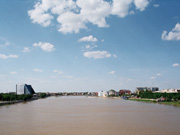| |
THE TIME OF JOLLY MISSIONS,
OR COMBINING BUSINESS AND PLEASURE
LAND OF CHEAP STURGEON AND EXPENSIVE GASOLINE
(Atyrau City)
By now Uralsk has been finally connected with Atyrau by a normal automobile road. But in the spring of 2005 only half of the road had been built, and its second half represented various impassable parts, trip over which was akin to participating in rally Paris Ц Dakar. It took us over 12 hours to cover 500 kilometers lying between the two cities on a small bus.
I will not argue that the oil-capital of Kazakhstan is rather an expensive city. But not as much as some people try to represent. And it is possible to rent a tolerable flat here at a relatively reasonable price. Flesh of surgeon that is sold throughout the country at a fabulous price, costs here some 300 tenges for a kilogram. True, due to absurd coincidence, the price of gasoline, though oil from which it is produced here is extracted not far away, is far from low.
In Atyrau love and genuine admiration for sturgeon are peculiar only to newly arrived guests. The local population (as well as those who have lived a couple of years here) regard this СdelicacyТ as something usual, like chicken or beef (by the way, fish in Atyrau costs cheaper than any kind of meat). While selling fish to a visitant (whose eyes are evidently shining quite in a different way than the local populationТs, thus making his recognition faultless), the sellers would always warn him of the necessity to put the fish into an opaque packet immediately, and not to brandish it on leaving the market. Indeed, low prices are usually peculiar to poacher production.
 |
Ural River |
There is a thing, or more precisely a fact, the pride of which is characteristic of all Atyrau residents. I am speaking about the interesting location of the city on the two opposite banks of the Ural River which is usually considered the boundary between Europe and Asia . One of the bridges across the river, situated in the center of the city, even has special inscriptions С Europe Т and С Asia Т on each side. Actually, it feels rather nice and somewhat unusual to stand in the middle of the bridge looking in the dark waters of the Ural and understand that you are at the juncture of the two great parts of world. People of rich imagination, like me, are especially impressed by this.
The vicinity of the river, having positive moments like evening strolls along the quay and ice fishing, results in some negative things as well. Thus, for example, humid air is peculiar to the city, and people who arrived there for the first time from perhaps Central Kazakhstan known for its dry climate, get used for a long time to an unpleasant feeling when the air seems like wadding which sticks in the throat and does not let breathe easily. They say that it is over after some time you spend there. But what will not be over is hordes of gnats, midges and other swarming and stinging fraternity. Sometimes the efforts of the authorities to poison vermin (which look a bit frightening, like white smog on the quay blown from special equipment) will kill the citizens rather than gnats.
Atyrau is distinguishable for another interesting place that bears the name СAmerican villageТ among the residents. Officially this СvillageТ is called СDostyk Residential ComplexТ. Here live employees of Tengizshevroil, the company on which todayТs prosperity of the city is mostly based. It is often said that this islet of America on the bank of the Ural entirely equipped with everything American, reminds by its appearance a military fort rather than a residential complex.
While new Atyrau is growing large, the old city which first appeared on the СEuropeanТ bank of the Ural in 1640 is becoming smaller with every year. New building projects accomplish what was began at the Soviet time. The process of ruining old buildings cannot be turned backwards, and even the residents of Atyrau admit that the precious architectural monuments literally rack and ruin before their eyes. However, in the city where a lot of people arrive in order to earn their living no one is concerned with the evidence of the past. In fact, the thoughts of the majority of local inhabitants (both constant and temporary) are turned exclusively towards their future, full and successful future.
People from all parts of Kazakhstan are now working and living in Atyrau. Oil-gas industry is certainly predominant, but the representatives of other fields of activity will find their business here: road construction, health protection, security services, entertainment and many others, for everyone wants to have a piece of a big pie called С West Kazakhstan Т.
|



